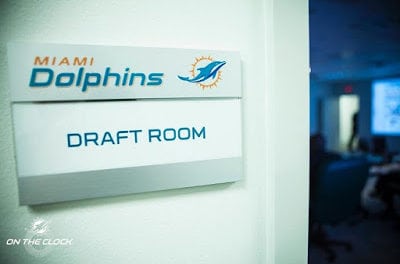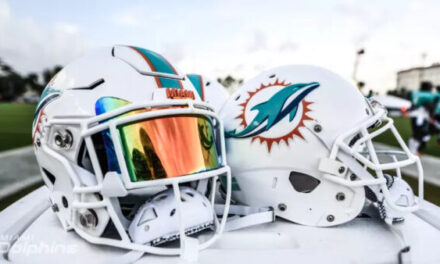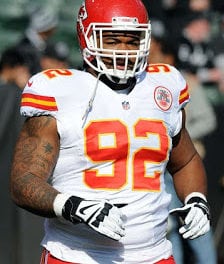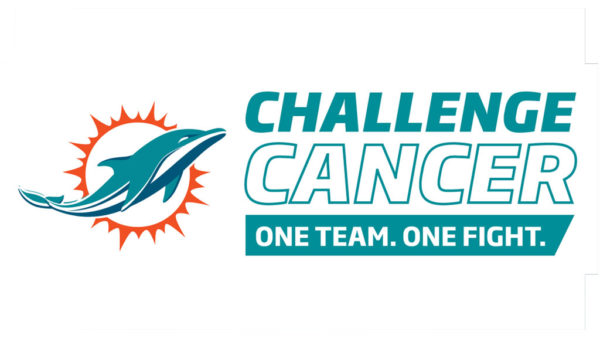
“A high school play,” long snapper Bob DeMarco said after Miami’s second straight preseason loss. “There’s no excuse for something like that.”
DeMarco was not a rookie trying to make the team. Rather, he was entering his twelfth year in the NFL and his third as the Dolphins long-snapper. He was referring to a snap for what would have been the equalizing extra point in Miami’s game vs. the Green Bay Packers. Dolphins running back Hubert Ginn had scored from two yards out with 1:55 remaining in the game to draw Miami within 14-13 of the visiting Packers.
DeMarco’s snap was high, deflecting off holder Karl Noonan’s outstretched hands. Dolphins radio announcer Rick Weaver said, “he would have needed a stepladder for that one.” Noonan and kicker Garo Yepremian gave chase to the rolling football. For reasons that would become clear in January, it was fortunate that Yepremian did not reach it and pick it up. Noonan recovered the ball and was quickly brought down by a Packer defender.
It did not work out well for Noonan, who would soon be taken off the field on a stretcher with his career suddenly in doubt. The only Dolphin who had played in every regular season game since the franchise debuted in 1966, Noonan had landed hard on the unforgiving new Poly Turf field. His left shoulder was separated, then he took a hard blow to the chest from his tackler. Noonan staggered off the field, then collapsed on the sideline. He was quickly administered oxygen and rushed to the hospital.
The chest pain and breathing difficulties he experienced landed Noonan briefly in the cardiac ward at Miami’s Mercy Hospital. He was quickly cleared of any concerns about his heart and scheduled for surgery to repair his separated shoulder.
Complicating matters was the fact that Karn Noonan was one of 18 Dolphins players at that time playing without a signed 1972 contract. If they made the roster, they were guaranteed a minimum of 90% of their prior year’s salary. Up until 1969, an injured player like Noonan could be let go without any salary due to them. The latest collective bargaining agreement between the NFL owners and players, however, rectified that and guaranteed their full prior year’s salary. However, his status for this season, as the kick holder and Paul Warfield’s backup at wide receiver, was very much in question.
[pickup_prop id=”22284″]
Noonan’s injury may have been less severe on natural grass, but the Orange Bowl featured Poly Turf, a newer brand of artificial grass. This was the second iteration of it in Miami, the first one lasting only two years.
In 1971, the Orange Bowl field had become notoriously slick, reaching a peak of absurdity in a Dolphins-Jets game where 59 players slipped and fell. One Patriots lineman said that season the field was like “playing on ice.’ Officials at Biltrite, the makers of Poly Turf, had deduced that the extra-strong ultraviolet rays in Florida sunshine was the culprit, so they installed a new field with a different composition for the 1972 season. They had also conducted extensive tests on which types of shoes would be most likely to keep players on their feet.
It is worth remembering; however, that like all other artificial turf fields of the time, the one at the Orange Bowl was laid over asphalt, you know, that stuff that roads are made of and which is not known for its cushion. Players like Mercury Morris and Paul Warfield, who relied on their speed, however, were delighted with the new turf.
Don Shula, however, was delighted about nothing. His Dolphins now stood at 0-2 in the preseason. The Miami Herald’s Edwin Pope said, “Shula looks upon exhibition results as only slightly less significant than the development of the hydrogen bomb.” That attitude would explain why his Baltimore Colts posted a preseason record of 32-4-1 during his seven seasons as head coach (what it is about Baltimore teams dominating preseason?). Shula’s Dolphins, however, now stood with a 6-7-1 preseason record early in his third season in Miami. That, folks, was a losing record for a coach that simply did not tolerate losing. His feelings were captured in a photo on the front page of the Herald’s sports section, which showed the coach during the Packers game with a classic grumpy face.
Miami’s starters, for the most part, played the entire first half. Green Bay took a 14-7 lead in at halftime on the strength of 101 yards rushing and a 79-yard touchdown pass from Scott Hunter to Dave Davis. The long touchdown pass particularly irked Shula, “Again, for the second week in a row, we give up a cheap touchdown. It’s something we can’t let happen.”
Even more galling to the head coach would be that the Dolphins, in the words of the Herald’s Bill Braucher, “were outhit by Coach Dan Devine’s scrappers, who are not supposed to be going anywhere in particular this season” (they would win the NFC Central). Safety Jake Scott and defensive end Bob Heinz both got what would likely be called concussions today.
Scott “got hit in the head, and the doctor said he was a little fuzzy,” Shula reported and even joked, “Of course, with Jake, that’s nothing new.” Social media would likely have a meltdown about a coach joking about one his players being hit in the head today, but it was not an issue in 1972. Heinz “got his bell rung,” a popular euphemism for a potential concussion at that time.
Miami’s first home game of 1972 was witnessed by a sellout crowd of 75,372, the fourth-largest crowd in Dolphins history at that point. The extra seats in the east end zone had not yet been added. Miami fans had to pony up $7 per ticket, with all three home preseason games included in their season ticket plans.
The Associated Press reported that the NFL owners were estimated to have grossed a combined $22 million in 1971 from ticket sales for preseason games. This was a major profit center for the teams since the player salaries did not kick in until the regular season opened.
For the 1972 preseason, players in their fifth season or greater were paid $340.56 per game. Four-year men received $258, $175.44 for three-year players, and two-year men $92.88. Rookies played for the “fun” of it, receiving no pay whatsoever for preseason. Each player, regardless of tenure, received $13 a day for expenses and had meals prepared for them at camp. Doing the math, so you don’t have to, a five-year plus player could earn a total of $2,043.36 for the six preseason games plus about $750 per diem.
Players association director Ed Garvey had already floated the idea of a sixteen-game regular season with four preseason games, which did take effect in 1978. At this time, however, an NFL spokesman said such a format could cause most of the teams to lose money.
To offer some perspective, the total that the NFL received from ABC, CBS, and NBC combined in 1972 for broadcast rights was $47 million, which would increase to $54.5 million in 1973. The average player’s salary was reported to be in the $27-28k range.
Miami owner Joe Robbie had just won an important financial victory in court when the Department of Justice stated the IRS had made a mistake when they ordered the Dolphins to refund $156,000 of ticket revenue. In 1971, President Nixon had issued wage and price controls designed to rein in inflation. Miami had increased ticket prices by $1 per seat in 1971, and the IRS had initially ruled that increase to be in violation of those wage and price controls. That was real money to an NFL owner in 1972, most of whom did not have huge fortunes anywhere near comparable to today’s owners.
Don Shula, even though he was still a 10% owner of the team, wasn’t worried about the bottom line at that time.
He wanted to win. No, he expected to win, whether he was playing hopscotch or just a meaningless preseason game. At 0-2, it was time for his Dolphins to break through in the win column when they traveled to Cincinnati for their next test.
At least one issue would be easy for Shula to solve. Needing a new holder for placekicks, he would turn to quarterback Earl Morrall. Morrall had been nursing an abdominal injury, which may have contributed to his dismal showing in the preseason opener. He was an experienced holder, having filled that task the prior four seasons with the Colts. In the first two of those seasons, Baltimore’s kicker was Lou Michaels, who, like Garo Yepremian, was left-footed.
Earl Morral would prove to be a very handy guy to have around during the 1972 season.
Coming Next Week: Part 4-A Crowded Backfield
The Dolphins break through into the win column in Cincinnati, and Mercury Morris continues to stake his claim for more playing time. Injuries pile up and force the Dolphins to try a linebacker at defensive end.
[pickup_prop id=”22292″]
[pickup_prop id=”22329″]
[pickup_prop id=”21810″]
[pickup_prop id=”26563″]













